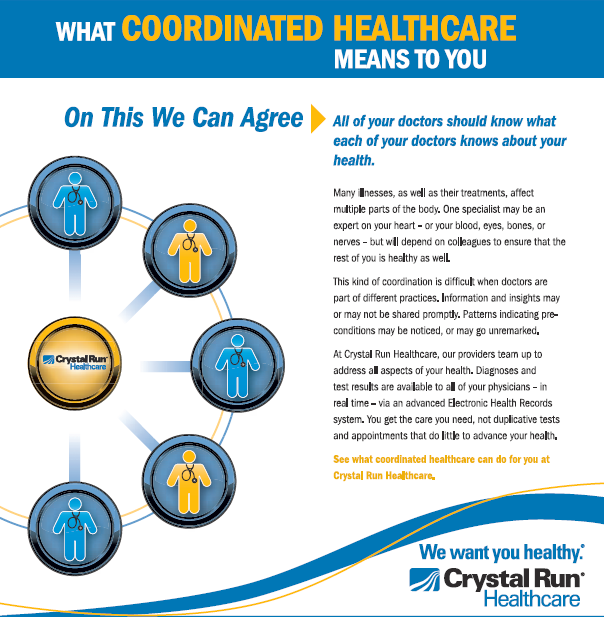We are entering a new era of consumerism in health care: highway billboards promote hospitals that own state-of-the-art MRI machines; television ads advertise urgent care clinics with minimal wait times; and magazines capture state-of-the-art surgical centers with the latest robotic technology. Perhaps most importantly, the rise of high deductible health plans and the emergence of health insurance exchanges are causing consumers to be far more cost conscious about where, when and from whom, they seek their care.
Appropriately, the healthcare marketplace is beginning to respond. Multiple states now have price transparency initiatives through which patients and caregivers can learn how much certain hospitals and providers charge for services. Earlier this year, Medicare released a large volume of health claims data revealing provider utilization and costs of services, and several commercial health plans are expected to follow suit. In addition, quality reporting programs such as the Centers for Medicare and Medicaid Services (CMS) Hospital Compare and Nursing Home Compare can provide basic information to help guide consumer decision-making.
Efforts to reign in health costs have accelerated the development of narrow network and managed care insurance plans where patients are limited to providers pre-specified by their insurance plan. Accountable Care Organizations (ACOs) are also proliferating as mechanisms to bend the health care cost curve. A recent analysis identified over 600 ACOs in the United States, and that number continues to grow at a rapid rate. As of January 2014, within the Medicare program alone, there are 366 ACOs that serve over 5 million patients.
Unlike commercial payers who often combine narrow (or tiered) networks and accountable care arrangements, Medicare ACO patients are not limited to specific providers. By allowing patients freedom of choice, Medicare preserves this highly valued commodity of patient autonomy. However, the downside in preserving patient choice is leakage. A recent study found that over a two-year period, only 66% of Medicare ACO patients are consistently assigned to the same ACO. This level of inconsistency can severely impede an organization’s efforts to identify and target patients using important tools like population health management and care coordination.
Barriers to Engaging Patients
A major challenge in educating patients about ACO benefits is CMS’ strict regulation of patient outreach materials. For example, upon entering a Medicare Shared Savings ACO, all patients receive a standardized letter from CMS indicating their provider’s ACO participation and allowing patients to opt out of sharing claims data.. Yet, many patients report that they do not remember receiving the letter, or they didn’t understand the letter. While Medicare does provide an informational FAQ brochure for patients, CMS must review any additional promotional or marketing materials.
Educating patients about the benefits of accountable care is a tricky proposition, as patients often believe that more expensive care equates with better care, and are thus reluctant to make personal medical decisions based on cost. For example, patients may care about the overall cost of health care when it comes to others, but when it comes to their own care, they often want everything done – and that means MRIs for back pain and antibiotics for viral infections – treatments that are not recommended using evidence-based guidelines. Thus, marketing value-based care could backfire for a provider organization, as patients could claim that they are being denied care by physicians who are trying to save money; a common refrain from the HMO era.
Crystal Run Healthcare
Through effective patient engagement and outreach, an ACO can effectively streamline patient care and provide a comprehensive range of services, while reducing redundancies, unnecessary visits and procedures, and eventually—unnecessary costs. Those who do so will benefit from additional services that are not provided (because they are not reimbursed) in non-ACO practices, such as population health and care management services.
Crystal Run Healthcare is a Medicare Shared Savings ACO that is leading the way in promoting the benefits of value-based-care. The multi-specialty practice achieved NCQA ACO designation, and is supporting providers in their efforts to adopt Choosing Wisely guidelines (www.choosingwisely.org). Crystal Run providers are creating a data warehouse with monthly report cards that help identify areas for improvement; embedding care managers within each primary care clinic; providing home visits for complex patients; and launching a telehealth program.
Few, if any of these offerings are reimbursed in fee-for-service arrangements, but Crystal Run has already seen reductions in hospitalizations, and improvements in diabetes control and patient satisfaction. Despite the challenges of discussing costs with patients, Crystal Run Healthcare has decided that reorienting patient attitudes about value is not only important, but is also essential for the success of accountable care. The theme of Crystal Run’s most recent advertising campaign, “On This We Can Agree” is that more isn’t necessarily better when it comes to health care.

Through a series of television, radio and print advertisements, the advertisements present statements such as:
- Healthcare should be judged on whether it makes you healthier
- Your goal is more health, not more tests and procedures
- Healthcare should cost what it needs to cost, and no more
Dr. Hal Teitelbaum, CEO of Crystal Run, feels that until patients actually believe the mantra that “less is more,” it will be very difficult to bend the cost curve in US health care. However, there are pathways forward. The movements for transparency of both cost and quality data could help show patients that cheaper care may actually be better care. Public quality reporting of meaningful outcomes can go a long way towards achieving such goals. According to Dr. Teitelbaum, “If the public saw that higher quality care could be had at lower cost, that would make a difference.”
The Brookings Institution is committed to quality, independence, and impact.
We are supported by a diverse array of funders. In line with our values and policies, each Brookings publication represents the sole views of its author(s).



Commentary
Improving Communication with ACO Patients
July 14, 2014